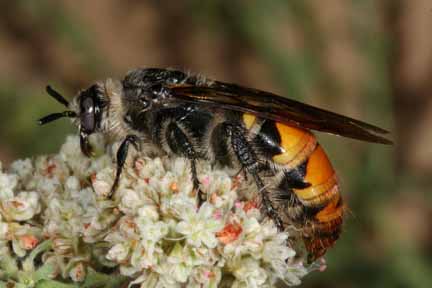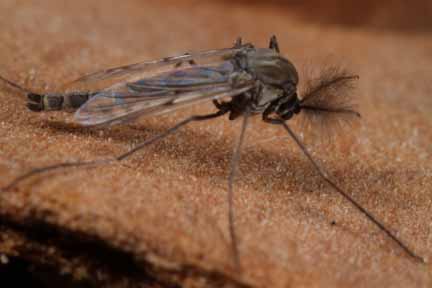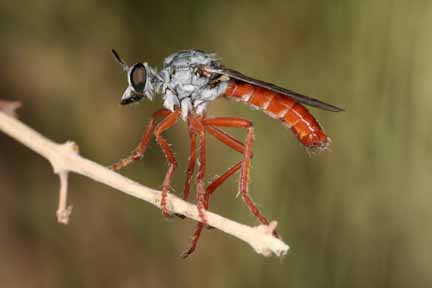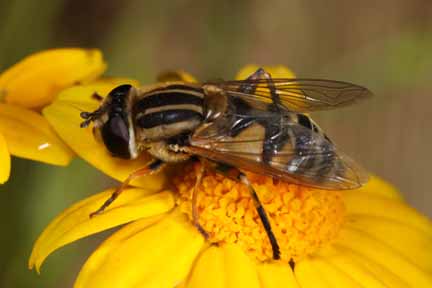|
Some common insects
of
the
San Jacinto Wildlife Area
Story and Photos by Greg Ballmer, retired UCR Entomologist
The San Jacinto Wildlife Area (SJWA) is crawling with arthropods. They are also swimming in the water, flying in the air, and burrowing in the soil. While California’s natural communities of plants and animals are in serious decline in many other places, the SJWA encompasses healthy examples of several habitats, each with its own distinct complement of plants and animals, the most numerous of which are arthropods (chiefly insects, mites, and spiders). Unlike vertebrate organisms, which have internal bony skeletons, arthropods have a chitinous exoskeleton, which must be shed periodically as they grow; this physiological imperative is the key to their unsurpassed diversity and abundance.
Because most insects undergo radical changes in form as they mature (metamorphosis), the behaviors and ecological specializations of the immature stages often differ markedly from those of the adults. Thus, the wingless immature stages of many insects are specialized for efficient feeding and rapid growth, while the winged adults are specialized for reproduction and dispersion. For the most part, insects can be divided into two groups, based on differences in their pattern of development. The Hemimetabola includes those insects in which the immatures gradually change to look more and more like adults with each succeeding molt, such as dragonflies, grasshoppers, and plant bugs. The Holometabola includes all insects which have four distinct life stages (egg, larva, pupa, adult), each having a distinctly different form and function. Thus, for example, the caterpillar stage of a butterfly is wingless and has chewing mouthparts for eating leaves, while the adult stage is winged and has tubular mouthparts specialized for feeding on the nectar of flowers; radical transformation from caterpillar to adult occurs during the immobile intermediate pupal stage. The wings of adult insects facilitate searching for new food sources, finding a mate, and dispersing to seek new places to colonize.
Insect metamorphosis also provides a mechanism which enables dormancy (diapause) during seasons which are not amenable to growth and reproduction. The process of molting (ecdysis), as well as the duration of each life stage, is mediated by hormones, which are produced (or not) in response to environmental factors such as food quality, temperature, moisture, and day length. The environmental cues which trigger onset or termination of diapause differ among species; in the absence of such cues, metamorphosis is arrested and dormancy ensues. For example, insects which rely on ephemeral food resources (e.g. spring wild flowers) are generally active only during a short period while their larval host plants are available, but remain dormant throughout the remainder of the year. Each insect species has its own characteristic diapause stage (egg, larva, or pupa) and season of emergence from diapause. The majority of insect species inhabiting the SJWA have a single annual generation and are active as adults only during the season most appropriate for their reproduction. Some species may even remain dormant for multiple years, such as during prolonged periods of drought.
Because of their small size and propensity for narrow ecological specialization, various arthropods inhabit a broad spectrum of habitats ranging from dry rocky slopes to open water. They collectively provide a wide range of ecosystem services, such as flower pollination, soil aeration, and nutrient recycling; at the same time, they also provide food for many small vertebrates and other arthropods. While the vast majority of arthropods at the SJWA are seldom seen, due to their small size and occurrence in the water, underground, or in other concealed situations, their presence is critical to the ecosystem’s health.
Many insects are strictly aquatic in their immature stages (larvae, naiads, or nymphs), while the winged adults are active fliers and may be found far from water sources. Of these, the most conspicuous are dragonflies and damselflies, which often forage in upland habitats far from the water sources where they grew up. The adults of many other aquatic insects, such as mayflies, caddisflies, mosquitoes, and midges, generally remain near water but may fly more distantly in search of food, mates, and new water sources during the night.

Scoliid Wasp
|
Conspicuous insects of upland habitats include various grasshoppers, butterflies and moths, ants, bees and wasps, beetles, flies, and plant bugs. Often these insects occur in close association with their specific host plants, which, in turn, occur in characteristic plant communities (e.g. alkali scrub, marsh, riparian forest, sage scrub, etc). A relatively few species occur across several habitats and plant communities.
The following compendium of arthropods occurring within the SJWA is organized by class and order and includes only the most conspicuous representatives. For more in-depth discussion and broader treatment of the local fauna, one should consult regional references such as Insects of the Los Angeles Basin by Hogue (1993) and Insects of California by Powell and Hogue (1981). Nevertheless, even those references portray only a small portion of the overall arthropod diversity.
Class Insecta
Mayflies (Order Ephemeroptera)
The mayflies are perhaps the most primitive extant flying insects; together with the next order (Odonata), they differ from other insect orders in lacking a mechanism to fold the wings. Mayfly immatures (naiads) are aquatic herbivores and may be an important food source for other aquatic insects and small vertebrates. When mature, the naiads emerge from the water, climb up emergent vegetation, and molt into “subimagos” having opaque wings; a day or so later, they molt again to become clear-winged adults. Adult mayflies have no mouthparts and generally live only a few hours (long enough to reproduce). Mayflies hold their wings vertically over the body when at rest and have long filamentous “tails” emanating from the end of the abdomen. Adult mayflies usually remain near water, but may be attracted to lights at night.

Western Forktail
|
Dragonflies and damselflies (Oder Odonata)
Dragonflies and their more diminutive relatives, damselflies, represent an ancient group that ruled the air before birds evolved and even prior to the major diversification of other groups of flying insects. Both adults and the aquatic immatures (naiads) are predaceous. The naiads use their extensible lower lip (labium) to quickly snatch aquatic prey in a manner reminiscent of a chameleon’s tongue. Dragonflies are especially agile fliers and use their spiny legs as an aerial basket to catch smaller flying insects, such as midges and mosquitoes. Damselflies are noticeably slower, less agile, and are most often encountered resting on low vegetation near water. When at rest, dragonflies hold their wings outstretched to the side, while (most) damselflies typically hold their wings together over the body.
The largest and most conspicuous dragonflies at the SJWA are the green darner (Anax junius), multicolored darner (Aeschna multicolor), and the red skimmer (Libellula saturata), all of which have a body length of ca 2.5-3 inches. The less colorful pastel skimmer (Sympetrum corruptum) is smaller, but often more numerous, and commonly wanders into dry upland habitats. Several North American dragonflies , including Anax junius, exhibit migratory behavior, often following avian flyways.
Damselflies normally remain near water and are most often encountered resting on vegetation, rather than in extended flight. Their slender bodies are often blue or green, with darker bands.
Grasshoppers, crickets, and katydids (Order Orthoptera)
Most of the well known orthopteroid insects are recognizable by their enlarged hind legs, suitable for jumping, and wings folded back over the body when at rest. Many species are also known for their ability to produce sound by stridulation: crickets chirp, katydids click and some grasshoppers “crepitate” while in flight. But most grasshoppers are silent, as are the flightless Jerusalem crickets.
Crickets are nocturnal and often abundant in dry habitats. Compact, blackish field crickets (Gryllus) are concealed in soil cracks or under debris by day, but their presence is belied by their chirping songs which permeate the night. More diminutive are slender, pale tree crickets (Oecanthus) which inhabit shrubs and trees; their song is a distinctive, sustained trill.
Katydids are also nocturnal and (like tree crickets) typically inhabit shrubs and trees. They generally resemble grasshoppers, but have slender antennae longer than the body, while the antennae of grasshoppers are much shorter. The angular wing katydid (Microcentrum rhombifolium) produces short ticking calls during late summer and fall.
Several species of diurnally active grasshoppers occur at the SJWA. Perhaps the most common are the pallid wing grasshopper (Trimeritropis pallidipennis) and the red-wing grasshopper (Dissosteira pictipennis). Both of these species are commonly observed in open fields and on bare ground, such as unpaved roads.
Jerusalem crickets (Stenopelmatus) are robust, wingless insects with largely subterranean habits. They feed primarily on roots, but may also scavenge dead or decaying plant and animal matter. Adults occasionally wander about on the soil surface at night in search of mates, which they are able to locate by means of substrate-borne vibrations created by thumping their abdomens against the ground.
Mantids (Mantodea)
Three species of preying mantids occur at the SJWA. The California Mantid (Stagmomantis californica) and Mediterranean Mantid (Iris oratoria), an exotic species, are similar in size (2-3 inches long) and color (gray-brown or green) and occur on foliage. The Gray Ground Mantid (Litaneutria minor) is more diminutive (ca 1.5 inches long) and typically stays on the ground. All mantids are predators and use their raptorial front legs to snatch prey. Mantids have one generation per year; the eggs are produced in fall and hatch in spring, while the nymphs mature in summer.
Plant bugs, stinkbugs, chinch bugs, cicadas, leaf hoppers, etc. (Order Hemiptera)
The order Hemiptera is divided into two suborders: Heteroptera (plant bugs, chinch bugs, stinkbugs, assassin bugs, toe-biters, etc) and Homoptera (aphids, mealy bugs, scale insects, leaf hoppers, and cicadas). All hemipterans have piercing-sucking mouthparts specialized to feed on fluids of either host plants or (usually) insect prey. Many herbivorous species are narrowly associated with a particular host plant species, while predatory species are generally more polyphagous; some species opportunistically feed on both plants and insects. While the vast majority of hemipteran species inhabiting the SJWA are diminutive and require expert identification, a few are more conspicuous and distinctive.
Heteroptera
Perhaps the most frequently observed heteropterans are the Uhler’s and Say’s stinkbugs (Chlorochroa uhleri and C. sayi, respectively, in the family Pentatomidae); they are relatively large (ca ½ inch long), green, and often found on low vegetation. As the name implies, stinkbugs can secrete a pungent defensive odor when handled. Other conspicuous heteropterans include the predatory bee assassin bug (Apiomerus crassipes) and smaller ambush bug (Phymatis sp.), both in the family Reduviidae. These and a few other species of reduviids are often encountered on or near blossoms, where they prey on bees and other flower-visiting insects. Several species of much smaller plant bugs (generally < ¼ inch long) in the families Lygaeidae, Miridae, and Rhopalidae, are associated with their respective specific host plants.
A few heteropterans are aquatic or semi-aquatic. Of these, perhaps most frequently observed is the spider-like water strider (Gerris remigis), which has a leg span of about an inch and skates rapidly over the surface of still water in search of small insect prey. The wholly aquatic toe-biter (Abedus indentatus), which is about an inch long and preys on other aquatic insects and even small vertebrates, may occur in ponds at the SJWA, but prefers stream habitats. Two smaller and similar appearing aquatic heteropterans (both ca ½ inch long) are the backswimmer (family Notonectidae) and water boatman (family Corixidae); the former is predaceous on small aquatic insects, while the latter feeds on algae plankton.
Homoptera
Homopterous insects are wholly terrestrial and feed on plant fluids. This group includes many familiar insects, such as aphids, mealy bugs, leaf hoppers, and cicadas; there are many species and expert examination is usually required to identify them. Of these, by far the largest are cicadas (most species about an inch long), which are less often seen than heard, due to their characteristic and often loud stridulation. Cicada nymphs feed on roots (sometimes taking years to mature) and come to the soil surface only to molt into the short-lived adult stage.
Butterflies & Moths (Lepidoptera)
Many moth species occur within the SJWA, but most are diminutive, nondescript, and nocturnal. The Nevada Buckmoth (Hemileuca nevadensis), a conspicuous (wing span about 2.5 inches) diurnal species with black-and-white wings, flies during the fall months, usually in close association with its willow and cottonwood larval hosts. The spiny yellow-and-black larvae grow up to 3 inches long during spring and early summer; they should not be handled, as the spines can deliver a painful sting. Eggs are laid in clusters on twigs of the host plants and hatch during spring.
Most diurnal Lepidoptera are butterflies, of which about a dozen species regularly inhabit the SJWA. The Tiger Swallowtail (Pterourus rutulus) and Lorquin’s Admiral (Limenitis lorquini) are strongly associated with their larval hosts, willow and cottonwood trees, and may be observed (in a succession of generations) from spring to late fall. Other species frequently observed throughout much of the year are the Checkered White (Pontia protodice), and imported Cabbage White (Artogeia rapae) whose larvae feed on both native and introduced mustards and the Checkered Skipper (Pyrgus albescens) and Large White Skipper (Heliopetes ericetorum), both of which utilize larval host plants in the family Malvaceae. The familiar Monarch Butterfly occasionally visits the SJWA, but is not a stable resident, probably because there is no established colony of milkweed, its larval host.
Overall, the SJWA’s most conspicuous butterfly is probably the Painted Lady (Vanessa cardui), which may appear in large numbers migrating during winter and spring. Huge numbers of this species often build up in the desert regions of California and northern Mexico following abundant winter rain which promotes growth of several larval hosts; the adults then migrate northward and westward, often for weeks at a time. Two related but non-migratory species, the West Coast Lady (Vanessa annabella) and Red Admiral (Vanessa atalanta), may be present more reliably throughout the year, but in far lower numbers and often in association with their larval host, stinging nettle (Urtica dioica).
The Chalcedon Checkerspot (Euphydryas chalcedona) flies in late winter and spring, usually near its larval hosts, bush monkey flower (Mimulus aurantiaca) and bee bush (Scrophularia californica), which grow on rocky slopes. Another vernal species of the hills is the Desert Orange-tip butterfly (Anthocharis cethura), which is best observed on hill tops in late March. The Sara Orange-tip (Anthocharis sara) likewise flies during spring and is most likely to occur on or near the hills, but is less likely to display hill-topping behavior. Both orange-tip species use native wild mustards as larval hosts.
The smallest butterfly (<1/2 inch wing span), yet perhaps the most likely to be observed in all seasons at the SJWA is the Pygmy Blue (Brephidium exile). This small brown “blue” butterfly has multiple generations per year and uses a number of larval host plants in the family Chenopodiaceae, including various species of pigweed (Chenopodium), Russian thistle (Salsola), and saltbush (Atriplex). The Common Gray Hairstreak (Strymon melinus) also has multiple generations per year and uses several different host plants; although seldom abundant, this species may be observed in all terrestrial habitats throughout the year. Two other diminutive butterflies are the acmon blue (Icaricia acmon) and purplish copper (Lycaena helloides), which tend to be closely associated with their respective larval hosts, wild buckwheat (Eriogonum) and sorrel (Rumex).
Beetles (Coleoptera)
The order Coleoptera is probably represented by the greatest number of insect species at the SJWA; yet most of them are seldom noticed by casual observers. Beetle life histories are extremely diverse and often highly specialized. Many beetle species variously live under bark, burrow into living or dead wood and fungi, or feed on roots or leaves; many others are scavengers or predators; relatively few are aquatic.
Perhaps the most conspicuous beetles at the SJWA are various species of flightless darkling beetles (Tenebrionidae), all of which are scavengers. Of these, the most often encountered are various species of Eleodes, often called stink beetles (not to be confused with true stinkbugs in the order Hemiptera, referred to above) because they secrete a dark foul-smelling fluid when confronted by a potential predator. Eleodes armata (ca one inch long), the most common darkling beetle throughout the year, is often observed crawling slowly over open soil (sometimes climbing into low vegetation) in search of fallen flowers and leaves on which to feed. When disturbed, these shiny black beetles characteristically assume a defensive posture by lowering their heads and raising their abdomens (from which defensive fluids are secreted). The somewhat smaller Wooly Darkling beetle (Cratidus osculans) is covered with brownish hairs and may be common during spring. Larvae of most tenebrionid beetles live in soil and feed on roots and detritus.
Another group of dark ground-dwelling beetles belongs to the family Carabidae; these are mostly agile nocturnal predators of small soft-bodied insects. While most carabid beetles are less than ½ inch long, Calosoma semilaeve, sometimes referred to as the caterpillar hunter, is about twice that size (similar to Eleodes). This species is diurnally active in seeking cutworms and other caterpillars on which to feed and is usually seen ; it can be numerous during some years. As with Eleodes, Calosoma can secrete a strongly repellant defensive fluid when handled.
Various species of aquatic beetles (chiefly in the families Dytiscidae and Hydrophilidae) may be present at the SJWA, but they generally remain out of sight beneath the water surface. More visible are whirligig beetles (genera Dineutes and Gyrinus), which are about ½ inch long and swim rapidly, often in whirling swarms, at the water surface, where they feed on floating detritus. These beetles have remarkable eyes, which are divided for simultaneous vision both above and below the surface.
A number of beetle species in the family Scarabaeidae occupy terrestrial habitats at the SJWA. Several species commonly referred to as June beetles (ranging from about ¼ inch up to about an inch in length) are nocturnally active and are frequently attracted to lights, chiefly during spring and summer months. Scarabaeid beetle larvae feed on roots and decaying organic matter in the soil. Dung beetle larvae (including Egyptian scarabs, for which the family is named) feed on dung which the adults roll into balls and bury. The most likely dung beetle to be found at the SJWA is XXXYYY, a diminutive species (ca ¼ - 1/3 inch long).
Flies (Diptera)
As with the beetles, a great many kinds of flies inhabit the SJWA, and they occupy an extremely broad spectrum of habitat niches, especially in their larval stages. The larvae of mosquitoes, midges, and horseflies are aquatic and feed on micro-organisms and/or decaying organic matter, while the larvae of many other kinds of flies feed on organic matter in soil, decaying vegetation, animal carcasses and droppings; still others are leaf miners or gall makers within living plants. But the larvae of some of the most conspicuous fly inhabitants of the SJWA are predators or parasites of other insects; these include beeflies (Bombyliidae), hover flies (Syrphidae), and robber flies (Asilidae).
Adult flies also collectively display a wide range of habits. Thus, female mosquitoes and horseflies are famously blood-suckers, while the males may feed on nectar or even nothing at all. Many other kinds of flies also feed on nectar, while still others feed on decaying organic matter and plant sap or take water from wet soil; and some adult flies are predators of other insects.

Chironomid Midge
|
Several species of mosquitoes (Culicidae) and midges (Chironomidae) breed in aquatic habitats and, although physically small, may be conspicuous by their numbers and (in the case of mosquitoes) biting habits at night. These flies can be especially abundant during certain seasons and are extremely important in maintaining water quality, as their larvae feed on microbial organisms. Both adults and larvae of mosquitoes and midges are an important food resource for predatory insects and small vertebrates.
Crane flies (Tipulidae), sometimes known as mosquito hawks, resemble mosquitoes and midges in general appearance and are often mistakenly called “giant mosquitoes”; they do not bite. Some crane fly species may reach about two inches in body length, although most are in the ½-1 inch size range. The larvae of various species breed in aquatic and semi-aquatic habitats, moist soil, and decaying vegetation; some species are predatory, while others feed on roots or decaying organic matter. Crane flies have conspicuously long, delicate legs, which easily break off when handled.

Robber Fly
|
Robber flies (Asilidae) are often conspicuous due to large size (for a fly) and predatory habits. The larvae are predaceous on other insects in soil, while the adults feed on other flying insects, which they typically capture in flight. One notable robber fly occurring at the SJWA is the Bumble Bee Robber Fly (Mallophora fautrix), so-called because of its hairy black and yellow resemblance to a bumble bee. Other conspicuously large robber flies (up to ca one inch long) include members of the genera Efferia and Proctacanthus, which have elongate cigar-shaped abdomens and are generally some shade of gray.
Several conspicuous bee flies (Bombyliidae) are active during the warm months. Bombyliid flies are often clothed in hairs or scales and colored to resemble bees or wasps of similar size, which similarly visit flowers. Bombyliid flight behavior, including the ability to hover in place, also contributes to their ability to mimic bees. Bombyliid larvae of different genera variously feed on grasshopper eggs, bee or wasp larvae, or caterpillars.
In early spring rotund, fuzzy Bombylius (mostly B. major and B. albicapillus) may be observed visiting flowers (especially of Cryptanthus and Phacelia). The larvae of Bombylius are external parasitoids of bee larvae (chiefly anthophorine bees). During Spring, summer, and fall various conspicuous species of Anthrax, Conophorus, Lepidanthrax, Poecilanthrax, Thyridanthrax, and Villa are likely to be found visiting whatever blossoms are available.

Hover Fly
|
Hover flies (Syrphidae) resemble bee flies in general appearance and habits; they, likewise, frequently mimic bees and wasps. Hover fly adults often visit flowers to imbibe nectar, while their larvae are variously predators or scavengers in aquatic habitats and decaying vegetation. The larvae of several species are aphid predators.
Horseflies (Tabanidae) breed in aquatic and semi-aquatic habitats. The larvae are predators of other small invertebrates, while adult females famously feed on blood; males feed on nectar or not at all. The Big Black Horsefly (Tabanus punctifer), about an inch long, is most frequently encountered at the SJWA. Females often fly around visitors and may occasionally land on them to seek a blood meal.
There are many species of muscoid flies, including the common housefly and several other species of similar appearance. The Blue and Green Bottle Flies (Calliphoridae) are slightly larger than a housefly, bright metallic blue or green, respectively, and often found in association with carrion and garbage, on which the larvae (maggots) feed. Houseflies (Muscidae) are ubiquitous wherever people live and breed in decaying organic matter, including garbage and animal waste. Flesh flies (Sarcophagidae) resemble houseflies, but are often a bit larger and have a red-tipped abdomen. Adult flesh flies are often attracted to bare skin in search of moisture, while the larvae feed on carrion and animal waste or are parasites of other insects. There are several species of tachinid flies (Tachinidae), which generally resemble houseflies, but are usually conspicuously more bristly. Adult tachinids often visit flowers for nectar, while the larvae are parasites of various insects (especially caterpillars) and other arthropods.. |





